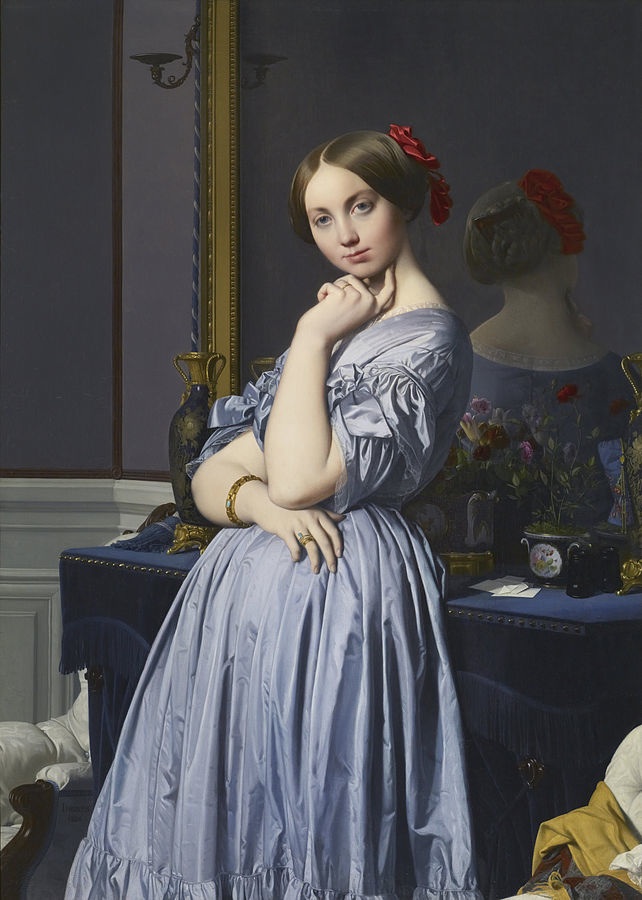Comtesse d’Haussonville
In lamentation that I have missed what looks to be an amazing Ingres exhibition at the Prado, I wanted to pick one of my favourite of his paintings for this POTM. The French painter started this portrait when he was in his sixties, and spent three years on it. The Comtesse is 24 years old, the embodiment of youth, beauty, wealth and fashion. But Ingres has managed to depict more than a pretty young lady in a stylish dress. We get a sense of her intelligence and personality from her pose and expression. The tilted head and doe-like blue eyes question us, but in a confident and coquette-ish way. Unlike most portraits we are included in the scene, enclosed in the same space as the Comtesse and there is a dialogue between us.
She stands in a beautifully furnished room before a mantelpiece. The mirror above it gives us a fortuitous glimpse of her lovely bare neck and her elegantly braided hair fastened with a tortoiseshell comb. Her blue gown is sumptuously silky, compositionally working with the blue of the room, the furnishings, her eyes and the stone in her ring. But the harmony is broken up by the mustard yellow shawl discarded over a chair, her gold jewellery, and the red ribbon in her hair, dotting the canvas with contrasting hues. This symphony of colour is very typical of Ingres, as is the ‘type’ of woman (creamy alabaster skin, a perfectly tear-shaped face, a curvy figure and a directly knowing look). Her proximity to us, her nonchalant pose and the way her tapered fingers are brought to her face (another popular Ingres device) make the scene feel informal and intimate. The fact that her right arm seems to be dislocated from its shoulder is of little importance, it doesn’t bother me at all. The Comtesse’s expression is quite ambiguous, not unlike that of the Mona Lisa.
The decor and objects in the room tell us more about the Comtesse, her tastes and social life; ornate vases and wild flowers, calling cards (corners folded telling us she was not at home) and opera glasses (perhaps why she was not at home). Wife to a diplomat and mother of three, she was an accomplished and busy modern woman. Her grandmother was Madame de Staël, lady of letters and a political and intellectual enemy of Napoleon. Outspoken, liberal and passionate the Comtesse said of herself ‘I was destined to beguile, to attract, to seduce and in the final reckoning to cause suffering in all those who sought their happiness in me.’ This portrait is beguiling and seductive, just as her character was.
Ingres’ portraits would not have been considered his most important work, but rather his history and genre paintings were what would have been admired. Like his tutor Jacque-Louis David Ingres was a perfectionist, and, right arm aside, the Comtesse is perfection. It is her dress that always catches my eye. It is so lavishly depicted that you can feel the texture with your eyes, it is almost iridescent. This painting is a symphony in blue, almost symphonic in its tonality. A politician and friend of the Comtesse wrote in a letter to the sitter “M. Ingres must be in love with you to have painted you this way”, and that the emotion that I feel just looking at her.

